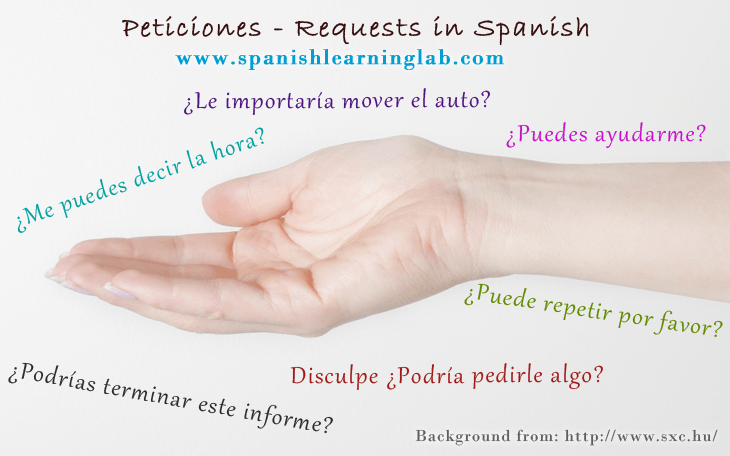Request in spanish language – Requesting in Spanish is an art form that involves a blend of cultural etiquette, politeness, and linguistic nuances. Embark on a journey to explore the intricacies of making requests in Spanish, from formal to informal settings, while gaining insights into the cultural factors that shape these interactions.
Delve into a comprehensive list of Spanish phrases tailored for making requests, organized by formality level, to empower you with the appropriate language for any situation. Discover the subtle differences between formal and informal requests, ensuring your communication is both respectful and effective.
Request in Spanish Language
Making requests in Spanish is an important aspect of communication, and it is essential to understand the cultural nuances and etiquette associated with it. There are several common phrases used to make requests in Spanish, and the choice of phrase depends on the formality of the situation and the relationship between the speaker and the listener.
Formal Requests
Formal requests are typically used in professional or academic settings, or when speaking to someone who is older or in a position of authority. Some common phrases used to make formal requests include:*
- *¿Podría por favor…? (Could you please…?)
- *¿Sería posible…? (Would it be possible…?)
- *¿Le importaría…? (Would you mind…?)
- *¿Me podría ayudar con…? (Could you help me with…?)
- *¿Le agradecería que…? (I would appreciate it if you could…?)
Informal Requests
Informal requests are used in more casual settings, such as when speaking to friends or family. Some common phrases used to make informal requests include:*
- *¿Puedes…? (Can you…?)
- *¿Me pasas…? (Can you pass me…?)
- *¿Me ayudas con…? (Can you help me with…?)
- *¿Me haces un favor? (Can you do me a favor?)
- *¿Me das…? (Can you give me…?)
Cultural Nuances
In addition to the choice of phrase, there are also some cultural nuances to keep in mind when making requests in Spanish. For example, it is considered polite to use the formal “usted” form of address when making a request to someone who is older or in a position of authority.
It is also important to be respectful and avoid using demanding or aggressive language.
Phrases for Making Requests
Making requests in Spanish can be done in a variety of ways, depending on the level of formality desired. Here is a comprehensive list of phrases that can be used to make requests, organized into categories based on formality level:
Formal Phrases
- ¿Podría por favor…? (Could you please…?)
- ¿Sería posible…? (Would it be possible…?)
- ¿Le importaría…? (Would you mind…?)
- ¿Me haría el favor de…? (Would you do me the favor of…?)
- ¿Tendría la amabilidad de…? (Would you be so kind as to…?)
Informal Phrases
- ¿Puedes…? (Can you…?)
- ¿Podrías…? (Could you…?)
- ¿Me pasas…? (Can you pass me…?)
- ¿Me ayudas con…? (Can you help me with…?)
- ¿Me haces un favor? (Can you do me a favor?)
Less Frequently Used Phrases
- ¿Te molestaría…? (Would it bother you to…?)
- ¿Te importunaría…? (Would it inconvenience you to…?)
- ¿Te incomodaría…? (Would it make you uncomfortable to…?)
- ¿Tendrías la gentileza de…? (Would you be so kind as to…?)
- ¿Serías tan amable de…? (Would you be so kind as to…?)
When making a request, it is important to be polite and respectful. The tone of voice and body language can also convey the level of formality desired.
Cultural Considerations

In Spanish-speaking cultures, requests are influenced by several cultural factors that shape the way they are made. These factors include politeness, respect, and indirect communication.
Politeness
Politeness is highly valued in Spanish-speaking cultures. When making a request, it is important to use polite language and avoid being direct or demanding. Instead, requests should be made in a respectful and considerate manner.
Respect
Respect is another important cultural factor that influences how requests are made. When making a request, it is important to show respect for the person you are asking. This can be done by using formal language, addressing the person by their proper title, and avoiding interrupting them.
Indirect Communication, Request in spanish language
Indirect communication is often used in Spanish-speaking cultures. This means that requests are often made in a roundabout way, rather than being stated directly. This is done to avoid being impolite or disrespectful.
Formal vs. Informal Requests

In Spanish, as in many other languages, there are two main types of requests: formal and informal. Formal requests are used in situations where you need to be polite and respectful, such as when you are speaking to a stranger, a person in a position of authority, or someone you do not know well.
Informal requests are used in situations where you are more familiar with the person you are speaking to, such as when you are speaking to a friend, family member, or coworker.
There are a few key differences between formal and informal requests. First, formal requests typically use more polite language, such as “por favor” (please) and “gracias” (thank you). Second, formal requests often use the third person, even if you are speaking to the person directly.
Third, formal requests may use more complex grammar, such as the subjunctive mood.
Examples of Formal and Informal Requests
Here are some examples of formal and informal requests:
- Formal:“Por favor, ¿podría ayudarme a encontrar mi asiento?” (Please, could you help me find my seat?)
- Informal:“¿Me ayudas a encontrar mi asiento?” (Can you help me find my seat?)
- Formal:“Gracias por su tiempo.” (Thank you for your time.)
- Informal:“Gracias.” (Thanks.)
As you can see, formal requests are more polite and respectful than informal requests. They are also more likely to be used in situations where you need to make a good impression.
Grammatical and Vocabulary Differences between Formal and Informal Requests
There are a few grammatical and vocabulary differences between formal and informal requests. Here are some of the most common:
- Formal:Use the third person, even if you are speaking to the person directly.
- Informal:Use the second person.
- Formal:Use the subjunctive mood.
- Informal:Use the indicative mood.
- Formal:Use polite language, such as “por favor” (please) and “gracias” (thank you).
- Informal:Use more casual language.
By following these tips, you can make sure that your requests are always polite and respectful.
Examples of Requests

To demonstrate different types of requests in Spanish, we have created a table below. It includes columns for the English translation, Spanish phrase, formality level, and cultural context. We have provided a variety of examples to cover different scenarios.
This table can be used as a reference guide when making requests in Spanish, ensuring that the appropriate level of formality is used and that the request is culturally appropriate.
| English Translation | Spanish Phrase | Formality Level | Cultural Context |
|---|---|---|---|
| Can you please pass me the salt? | ¿Puede pasarme la sal, por favor? | Formal | This is a polite way to ask for something in Spanish. It is typically used in formal settings or when speaking to someone you do not know well. |
| Could you open the window? | ¿Podría abrir la ventana? | Formal | This is another polite way to ask for something in Spanish. It is also typically used in formal settings or when speaking to someone you do not know well. |
| Excuse me, could you tell me where the bathroom is? | Disculpe, ¿podría decirme dónde está el baño? | Formal | This is a polite way to ask for directions in Spanish. It is typically used when you are lost or need to find a specific place. |
| Can I have a menu, please? | ¿Puedo tener un menú, por favor? | Informal | This is a more informal way to ask for something in Spanish. It is typically used when speaking to someone you know well or in a casual setting. |
| Could you help me with my suitcase? | ¿Podría ayudarme con mi maleta? | Informal | This is another informal way to ask for help in Spanish. It is typically used when speaking to someone you know well or in a casual setting. |
End of Discussion: Request In Spanish Language
Mastering the art of requesting in Spanish unlocks a deeper understanding of the language and the culture it represents. With a repertoire of appropriate phrases and an awareness of cultural norms, you can navigate conversations with confidence, building strong relationships and fostering meaningful connections.
Question & Answer Hub
What are some common Spanish phrases used to make a request?
Phrases like “Por favor” (Please), “Podría” (Could you), and “¿Le importaría?” (Would you mind) are widely used in Spanish to make polite requests.
How does cultural etiquette influence requests in Spanish?
In Spanish-speaking cultures, politeness and respect are highly valued. Indirect communication and avoiding direct confrontation are common practices when making requests.
What are the key differences between formal and informal requests in Spanish?
Formal requests use more elaborate language, such as “Le agradecería mucho” (I would greatly appreciate it), while informal requests are more direct and casual, such as “Hazlo, por favor” (Do it, please).